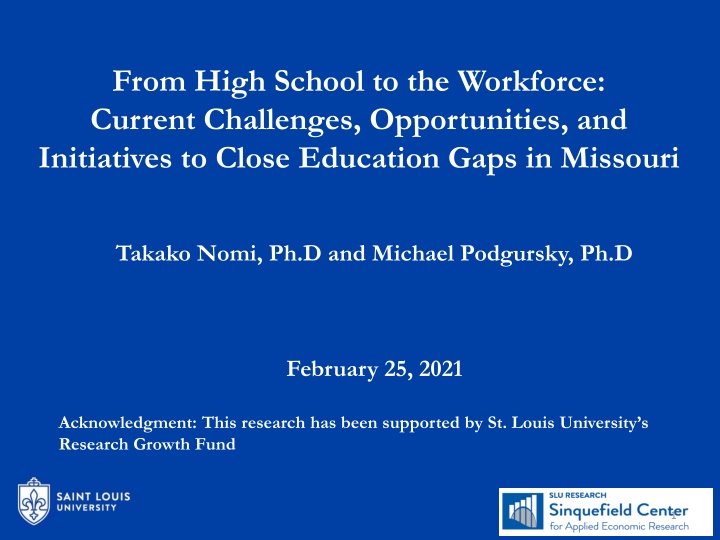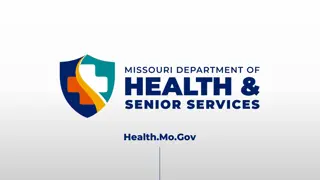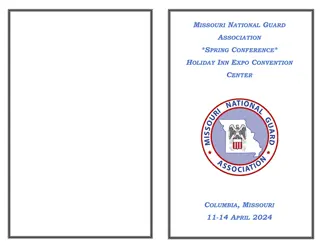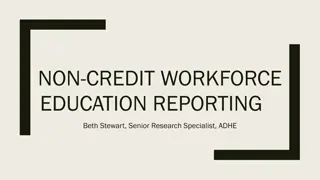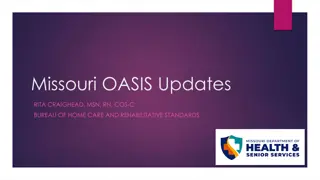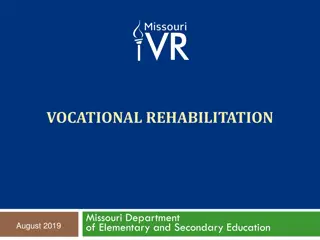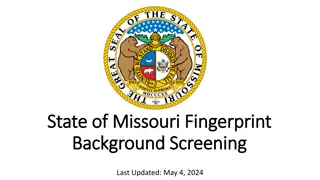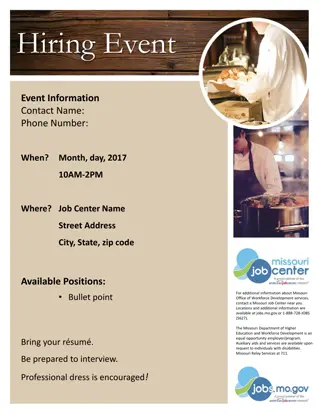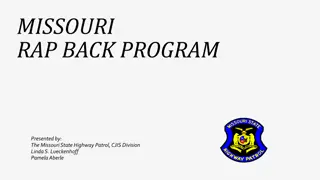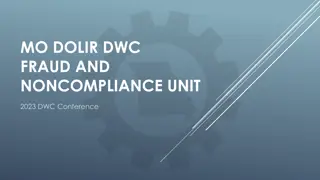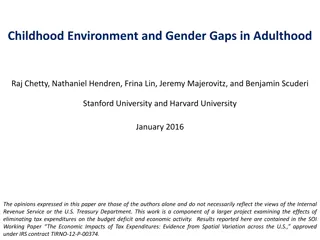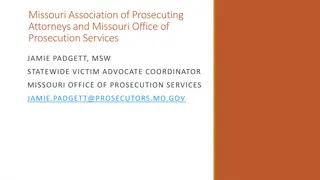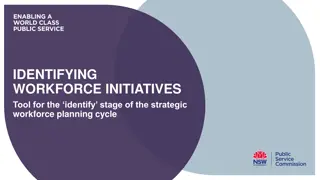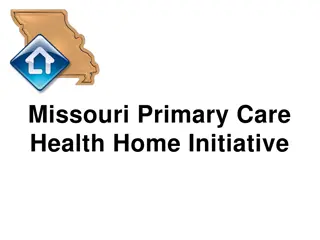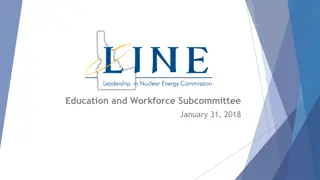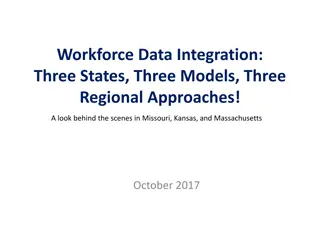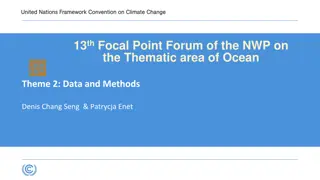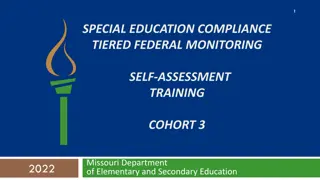Addressing Education Gaps for Missouri's Workforce Development
This research presentation discusses the current challenges and opportunities in closing education gaps in Missouri, focusing on workforce development needs, collaborations among stakeholders, and initiatives to support students and teachers. Key areas include understanding degree attainment trends, addressing gaps by race and gender, and upcoming opportunities such as the relocation of NGA to St. Louis. The research aims to improve pathways to the workforce, enhance teacher development, and conduct impactful educational research.
Download Presentation

Please find below an Image/Link to download the presentation.
The content on the website is provided AS IS for your information and personal use only. It may not be sold, licensed, or shared on other websites without obtaining consent from the author.If you encounter any issues during the download, it is possible that the publisher has removed the file from their server.
You are allowed to download the files provided on this website for personal or commercial use, subject to the condition that they are used lawfully. All files are the property of their respective owners.
The content on the website is provided AS IS for your information and personal use only. It may not be sold, licensed, or shared on other websites without obtaining consent from the author.
E N D
Presentation Transcript
From High School to the Workforce: Current Challenges, Opportunities, and Initiatives to Close Education Gaps in Missouri Takako Nomi, Ph.D and Michael Podgursky, Ph.D February 25, 2021 Acknowledgment: This research has been supported by St. Louis University s Research Growth Fund 1
Todays talk: Overview Highlighting our ongoing work in education research and new initiatives at SLU: 1) To understand the current challenge and opportunities 2) To address workforce development needs in our region and across the state 3) To strengthen collaborations among stakeholders to achieve the following goals: - Creating better pathways to the workforce and supporting students - Addressing instructional needs and supporting teacher development - Improving research capacity and conducting research to understand and inform how we are doing, the effectiveness of educational programs, and the progress we are making, etc. We would like to receive feedback from you 2
Todays talk: Two Parts Part 1: Understanding the current challenges a) Historical overview of post-secondary enrollment and degree attainment trends by race and gender groups in MO using the American Community Survey(ACS) b) Race-and-gender gaps in degree attainment by following a cohort of all first-time 9th-grade students in MO public high schools through 6 years in college (entering HS in AY2009-10) What factors explain the gap? Importance of pre-college academic skills 3
Todays talk: Two Parts Part 2 : Current opportunities and initiatives Relocation of National Geospatial-Intelligence Agency (NGA) to North St. Louis in 2025 SLU s role in supporting K-12 teachers, students, and workforce development Current research and capacity building through research Addressing the questions related to PLTW initiated by KC STEM alliance and developing research from there Working with the key stakeholders to help develop research agendas, initiate longitudinal data construction(linkage), and address questions that are important to our state using the data. 4
Part 1: Understanding the current challenges 5
Context: Critical Issues US Income Distribution, Labor Market, and Educational Attainment Trends: Growing income inequality in recent decades Growth in knowledge-based economy, requiring skills beyond high school Growing income gaps between those with and without post-secondary credentials (increasing college premium and wage polarization) Post-secondary degree attainment has increased over the last several decades But, degree attainment gaps have also grown by socio-demographic characteristics Addressing educational disparities is the key to future success of our youth 6
Growing educational attainment disparities in the US (4+ Years of Education) National trend by Brookings Institute (2017) 7
Do we see a similar pattern in MO? The first study looks at a difference in both college enrollment and attainment between white and black, male and female ACS respondents since 2000 (MO population trends) Do we observe growing gaps in both enrollment and attainment? (attainment gaps may be growing because enrollment gaps are also growing(?)) We can t make a causal claim here, but is the observed pattern consistent with the theory? College enrollment: Currently enrolled in college for age 18 to 24 For degree attainment: Holding a 4-year degree for age 24 to 36 Metro vs Non-Metro difference 8
Trend in College Enrollment by Race-Gender in MO, age 18-24 0.55 College Enrollment 0.45 0.35 0.25 0.15 2000 2001-2004 2005-2006 2007-2008 2009-2010 Year 2011-2012 2013-2014 2015-2016 2017-2018 WhiteFemale BlackFemale BlackMale WhiteMale Overall Large gaps overall--females leading males in both races After 2010, the trend is flat for white males and females, but the upward trend continues for black students The gaps are not widening over the last 10 years 9
Metro vs. Non-Metro Difference in College Enrollment Metro Area Race-gender gaps are stable since 2005 Black females are similar to white males Non-Metro Area Black females have the highest enrollment rate of all groups Black males have made larger improvement (now similar to white males) White Non-Metro students of both genders lag considerably behind their Metro counterparts. Few Metro vs non-Metro gaps for black students 10
Degree Attainment If all students are similarly successful in completing a degree once they enter college, then the degree attainment trend should follow the enrollment trend with a time lag (appx 6 yrs). However, evidence shows growing attainment gaps 11
Trend in 4+ Years of College Education by Race-Gender in MO, age 24-36 Bachelor's Degree & Higher 0.45 0.40 0.35 0.30 0.25 0.20 0.15 0.10 0.05 1990 2000 2001-2004 2005-2006 2007-2008 2009-2010 2011-2012 2013-2014 2015-2016 2017-2018 Year WhiteFemale BlackFemale BlackMale WhiteMale Overall Gaps have grown over time Females improved more than males in both groups Black males have made the smallest improvement 12
Metro vs. non-Metro Difference in Bachelor's Degree Attainment Metro Area Both female groups improved more than their male counterparts greater gender gaps within the same race Black males seem to have made the smallest improvement Non-Metro Area For all groups, non-metro students have lower 4-yr degree attainment than metro students White females is the only group showing improvements over time Black females showed downward trend 13
Summary on Historical Trends Our data shows: All groups have upward enrollment trends However, black males show little improvement in attainment Black females have similar, or higher enrollment than white males, but much lower 4-yr degree attainment Of those enrolled in college, 4-year degree non-completion rates may be rising for minority students (male students in particular) 14
Following one cohort of first-time ninth- grade students in MO public high schools (AY2009-10) Outcomes: College enrollment, any degree, and bachelor s degree attainment To what extent high school and student characteristics (FRL and academic backgrounds, including MAP and 9th grade GPA) explain the overall gaps? 15 15
College Enrollment 10 % Difference from white female White Female = 53.7% 5 0 -5 1) Total: Total average gap 2) Within School: Within HS average gap 3) + Student FRL: Within HS + age and FRL 4) + Student FRL + Achievement: Within HS, age and FRL + Math MAP 8th and 9th-GPA -10 -15 -20 -25 Total Within school plus Student FRL plus Student FRL & Achievement white male black male black female Large total gaps between white females and the rest of the groups (and males are behind females in both races) School factors and student FRL status explain more than 60% of the gap for minority students, but not for white males. Black males and females have higher college enrollment than white students with similar academic and family(FRL) background.
Any Degree White Female = 35.6% 0 % Difference from white females -5 1) Total: Total average gap 2) Within School: Within HS average gap 3) + Student FRL: Within HS + age and FRL 4) + Student FRL + Achievement: Within HS, age and FRL + Math MAP 8th and 9th-GPA -10 -15 -20 -25 -30 Total Within school plus Student FRL plus Student FRL & Achievement white male black male black female Much larger total gaps in degree attainment (any degree) for minority students than the gaps in enrollment School factors and student FRL status explain smaller gaps in attainment for minority students than their enrollment gaps After taking into account pre-college academic differences, small, but statistically significant gaps in degree attainment remain
4-year Degree White Female = 19.2% 0 % Difference from white female -5 1) Total: Total average gap 2) Within School: Within HS average gap 3) + Student FRL: Within HS + age and FRL 4) + Student FRL + Achievement: Within HS, age and FRL + Math MAP 8th and 9th-GPA -10 -15 -20 -25 Total Within school plus Student FRL plus Student FRL & Achievement white male black male black female Patterns are similar to any degree attainment, but high school factors do not explain any of the gaps in 4-year degree attainment. Pre-college academic background and FRL status explain the majority of the gaps in 4-year degree attainment For both attainment outcomes, gaps for minority students are larger for high achieving students (especially for black males)
Summary Minority students are more likely to attend college than white students with the same FRL status, test scores and GPA, but this does not translate into degree attainment degree attainment of minority students are lower than similarly prepared white students This suggests: Among those who enrolled in college, college dropout rates are higher for minority students than white students with similar academic preparation levels Importance of improving skills before they enter college, and continuing to offer support once they are enrolled in college These results are presented at MO Equity Summit in Nov, 2020. 19
Part 2: Current opportunities and initiatives 20
Talent Development Needs in STL and MO The opening of NGA-West in 2025 is expected to create a geospatial hub in St. Louis New job growth Direct employment of 3000+ and much more in private sectors Need for talent development and better pipelines from K12, college, to work How can we increase college readiness and support transition from high school to college and career? Problems Geospatial sciences are not taught in HS Geospatial science is a relatively new field and rapidly growing Few teachers are trained in this area What role can SLU play? 21
Current Development: High School Geospatial pathway will be added to the MO Career Pathways Program by DESE Faculty in the Geospatial Institute (GeoSLU) are providing technical assistance Instructional modules being developed by GeoSLU faculty Can be used for standalone courses or integrated in the core courses Implemented in local high schools, (e.g., Collegiate School of Medicine and Bioscience in SLPS, and more schools in the future) Needs for teacher training Introducing the subject and how special thinking can promote learning in the core subject with application examples Help teachers develop instructional material and lesson plans Teaching teachers application tools Plans to offer PD as DESE introduces the Geospatial Pathway 22
Current Development: HS to College Apprenticeship program by Gateway Global (non-profit) for HS and college-age students (earn while learning) Possibility to add peer mentoring by SLU students SLU 1818 to offer low-cost dual-credit courses Old model: Each school must have a teacher with qualification New model: One instructor teaches to students in multiple schools (combining online and face-to-face instruction onsite). Initially, SLU will provide an instructor Providing an opportunity for HS teachers to become an 1818 instructor through a post-bachelor program with a capstone course. Developing articulation agreement with STLCC and other community colleges 23
Other research agenda and collaborations 24
Working with MO Education Agencies (DESE and DHEWD) Developing the trusted relationship is the most critical component in data sharing Addressing the questions that they care, which include: Simple descriptive questions, such as how our students are doing after graduating from HS, the current levels of attainment disparities, what explains the observed disparities, how students cumulate credits in college, and to what extent students lose credits when they transfer to another school. These types of studies often generate conversations toward strategies for solution (How do we improve?) as well as the next research questions 25
Working with MO Education Agencies (DESE and DHEWD) Addressing the questions that they care (continued): Policy questions, such as how to measure teacher contribution to learning for state accountability system, whether instituting the state-wide common core curriculum(Core42) mitigates credit loss for transfer students, and whether adding an algebra requirement for the Missouri A plus program improves student success. Questions about certain programs, such as how PLTW (STEM pathway program) is preparing high school students for college and career in STEM. 26
New collaboration and future opportunities Project Lead the Way (PLTW) one of the DESE s Career Pathways Program KC STEM Alliance (Collaborative Network of educators, business partners and affiliates with a mission of generating a robust workforce in STEM for the KC region) wanted to know how PLTW students are doing as compared to non-participants Study led by UMKC, MU, and SLU researchers Creating reports that are also relevant to St. Louis and MO as a whole. The first attempt to link DESE data and DHE data About 70 percent of MO public school graduates who attended college go to MO public colleges We can know a lot more about student post-secondary progression from DHE records than NSC data 27
New collaboration and future opportunities Future opportunities Project Lead the Way (PLTW): By understanding how the program is implemented/expanded across the state over time, we will be able to evaluate the program impact more rigorously (next step) Simple descriptive studies can lead to a larger project Possibility of linking DHE data to workforce data (UI wage data) and developing research agenda around it 28
Summary SLU can play a vital role in creating educational opportunities for local students and statewide to support geospatial workforce development (all stakeholders acknowledge that this is our priority in the region) SLU can play an important role in supporting/conducting data- driven educational and social science research to support critical issues facing our state The relationships that we have developed over many years are critical to this (this includes our teacher ed and ed leadership programs) Building a relationship/collaboration among SLU, MU and UMKC adds to the trust we are building around research as well as research capacity to address key issues to our state 29
